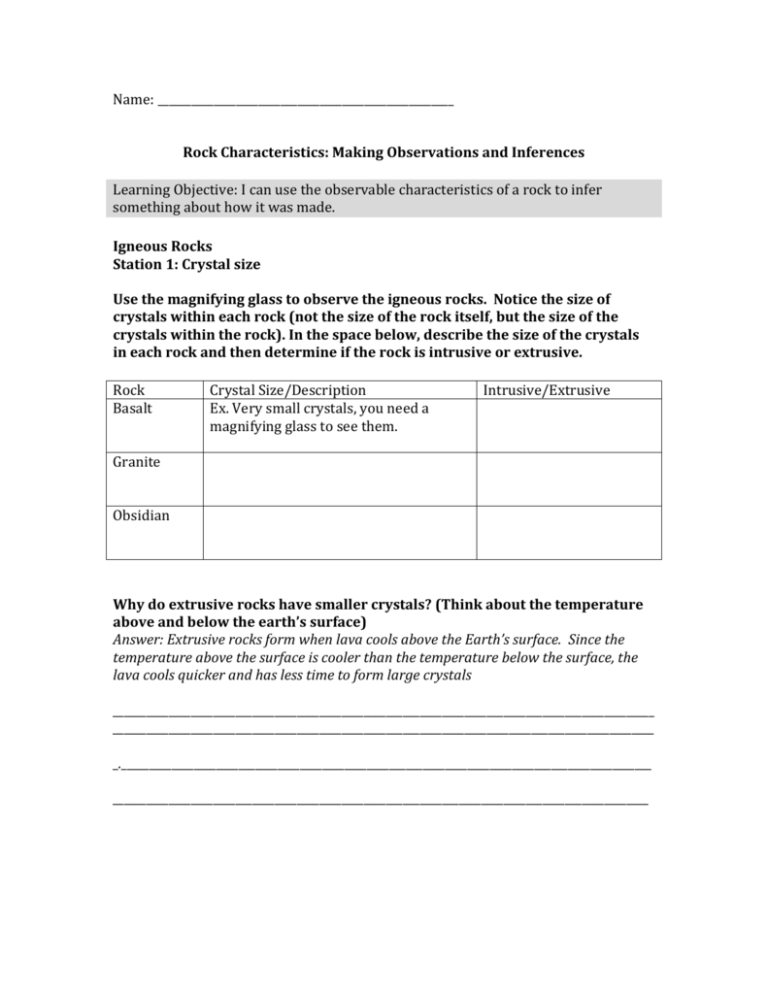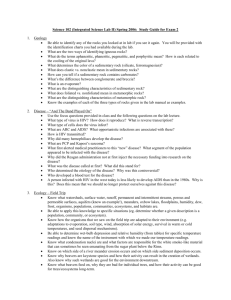Name: Rock Characteristics: Making Observations and Inferences
advertisement

Name: _____________________________________________________ Rock Characteristics: Making Observations and Inferences Learning Objective: I can use the observable characteristics of a rock to infer something about how it was made. Igneous Rocks Station 1: Crystal size Use the magnifying glass to observe the igneous rocks. Notice the size of crystals within each rock (not the size of the rock itself, but the size of the crystals within the rock). In the space below, describe the size of the crystals in each rock and then determine if the rock is intrusive or extrusive. Rock Basalt Crystal Size/Description Ex. Very small crystals, you need a magnifying glass to see them. Intrusive/Extrusive Granite Obsidian Why do extrusive rocks have smaller crystals? (Think about the temperature above and below the earth’s surface) Answer: Extrusive rocks form when lava cools above the Earth’s surface. Since the temperature above the surface is cooler than the temperature below the surface, the lava cools quicker and has less time to form large crystals _________________________________________________________________________________________________ _________________________________________________________________________________________________ _._______________________________________________________________________________________________ ________________________________________________________________________________________________ Station 2: Types of magma Igneous rocks can form from different kinds of magma. The type of magma influences the chemical and physical properties of the rock, and helps in classifying them. The three types of magma are Basaltic, Granitic, and Andesitic. Read about the magma type of each rock in the table. Then observe and record the color of the each rock. Rock Scoria Granite Pumice Diorite Magma Type Color of Rock Basaltic – rich in iron and magnesium, which makes this magma dark-colored. Granitic – rich in silica, which makes this magma light-colored. Andesitic – magma that has a moderate amount of iron, magnesium, and silica. It has a composition between basaltic and granitic magma. Explain in your own words why basaltic, granitic, and andesitic rocks are different colors. Igneous rocks can be made from magma with varying mineral composition. Basaltic rocks are darker because they are made of magma that is rich in the dark minerals Iron and Magnesium. Granitic magma is made largely out of the light colored mineral Silica. _________________________________________________________________________________________________ _________________________________________________________________________________________________ _________________________________________________________________________________________________ _________________________________________________________________________________________________ Sedimentary Rocks Station 3: Detrital Sedimentary Rocks Sedimentary rocks can be made out of almost any material found in nature. Therefore, they can be classified based on their composition (what they are made of). The three main types are detrital, chemical, and organic. In the table, describe the composition (what the rock is made of) and make a hypothesis about where you might find the rock. Rock Composition (What it’s made of) Example of a place you might this rock Conglomerate Sandstone Station 4: Chemical Sedimentary Rocks Sedimentary rocks can be made out of almost any material found in nature. Therefore, they can be classified based on their composition (what they are made of). The three main types are detrital, chemical, and organic. Chemical: Chemical sedimentary rocks form when dissolved minerals come out of a liquid. Minerals usually come out when they liquid they are in evaporates, leaving behind the mineral. The two beakers demonstrate a mineral that has come out of solution. One has saltwater that was kept at room temperature and the other had saltwater that was boiled until all of the water was converted to steam. In the space below, observe what you see. Dish with room temperature saltwater_________________________________________________________________________________________________ _________________________________________________________________________________________________ Dish with saltwater that was boiled_________________________________________________________________________________________________ _________________________________________________________________________________________________ Two examples of chemical sedimentary rocks are limestone and gypsum. Make observations of these rocks. Limestone - __________________________________________________________________________________ Gypsum- _____________________________________________________________________________________ Limestone is made of calcium carbonate (the material that shells are made of). Where could you find limestone? You could find it in a place where there used to be a large body of water that had animals with calcium carbonate shells. _________________________________________________________________________________________________ _________________________________________________________________________________________________ Station 5: Organic Sedimentary Rocks Sedimentary rocks can be made out of almost any material found in nature. Therefore, they can be classified based on their composition (what they are made of). The three main types are detrital, chemical, and organic. Organic: Two examples of organic sedimentary rocks are coquina and coal. In the space below, make observations of the rocks. Then, using what you know about their composition (what they are made of), where do you think these rocks may have formed? Rock Coquina Coal Composition Where might have the rock formed? Metamorphic Rocks Station 6: Foliated and Nonfoliated Rock Texture Observe the arrangement of mineral grains in the following metamorphic rocks (are there patterns in the grains of any of the rocks?). Then determine if the rock is foliated or nonfoliated. Rock Name Marble Observation Ex. Random arrangement of grains, all the same color Foliated/Nonfoliated Slate Gneiss Quartzite How does a rock get a foliated texture? When a rock is exposed to heat and pressure during metamorphism, its mineral grains can rearrange into bands of similar composition. _________________________________________________________________________________________________ _________________________________________________________________________________________________ _________________________________________________________________________________________________ _________________________________________________________________________________________________






